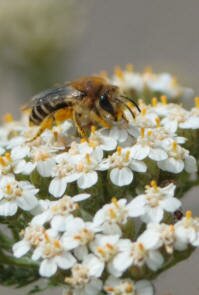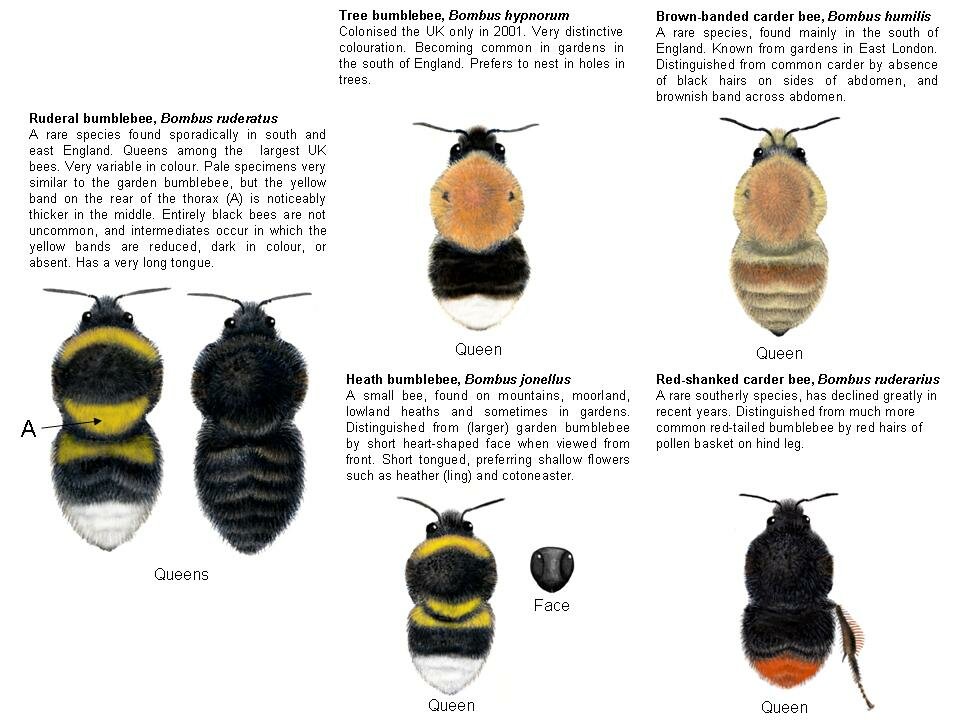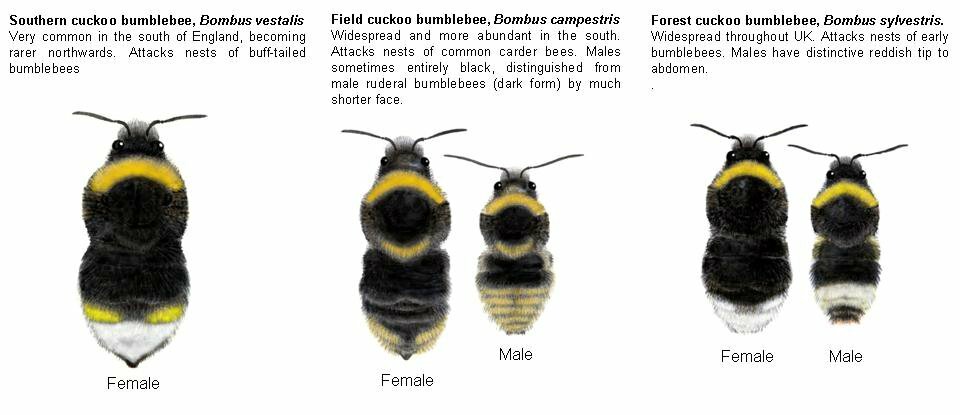|
What bee did I see?
Members receive a poster to help them with identification -why not join now?
|
Types of bee
A surprisingly large number of people are unaware that there are lots of different types of bee in Britain, including bumblebees (genus Bombus), honeybees (Apis mellifera) and numerous small solitary species. Bumblebees are the large, furry and often colourful insects that frequently feature in children’s books, cartoons and on greetings cards. Honeybees, widely kept in domestic hives for their honey, are smaller, slender, drab and relatively hairless.
  
A honeybee, a typical bumblebee and a small solitary bee (from left to right)
|
|
Identifying and recording bumblebees - take part in BeeWatch 2007!
Although they are familiar insects, there are surprisingly few bumblebee recorders, so that our distribution maps even for the common species have large holes in them. The range of some species seem to be rapidly contracting, while others are expanding, but the picture is far from clear. We really need your help recording bumblebees! Please download a recording form and let us know which species you have in your area. Try using the guide below, but if you are not confident of your identification, take a photograph with a digital camera and the photograph to us (including a post-code/grid-ref and a date). We will try to identify the bee and let you know what it is.
This following guide provides information on 14 bumblebee species, including all those that you are likely to encounter in your garden. Most can be readily identified from the colour pattern. You can get very close to bumblebees as they visit flowers – they are very rarely aggressive. The illustrations are mostly of queen bees, as workers generally have the same colour pattern but are smaller (except the buff-tailed bumblebee). For species in which the male differs in colour to the queen, separate illustrations are shown. With practice, males of all species can be distinguished by their longer antennae, and by the absence of pollen baskets on their hind legs.
To print - right-click on each guide and 'save picture as', then print using your computer's built-in software
|
The Big Six - Common bumblebees found in gardens
These six species are common in gardens throughout the UK apart from the far north of Scotland. In most gardens they will make up more than 90% of all bumblebees, so learning to identify these six is a major step towards becoming a bumblebee expert!

|
|
Rarer bumblebees that occur in gardens
Three of these species are severely threatened and have declined greatly in abundance (ruderal, brown-banded carder and red-shanked bumblebee). In contrast the tree bumblebee is expanding its range northwards in the UK, having arrived on the south coast from France about 6 years ago. The heath bumblebee is widespread but often overlooked because it is small and superficially similar to the more common garden bumblebee.

|
|
Cuckoo bumblebees
In the UK there are 6 species of cuckoo bumblebees (3 illustrated). These were once like other bumblebees, but they have switched to a parasitic existence. The females kill or evict the queen and take over her workers as their own, using them to rear their own offspring. If you live in the south of England, males of the southern cuckoo bumblebee can be among the most common bumblebees in July. Cuckoo bumblebees do not have pollen baskets on their hind legs - the area is convex and covered in short hairs.

All images modified from original artwork by Tony Hopkins
Still not found your bee?
There are a further 10 species of bumblebee not illustrated here but which you might see if you visit some of the UK’s wilder places. If you would like to learn how to identify these, why not join BBCT? You may find the following books and websites useful...
|

|
Books about bumblebees and wildlife gardening
Amazon will donate 10% of every book sold via these links to BBCT
|
|
Benton, T. Bumblebees. New Naturalist Series
An excellent and detailed account of all the British species, including their identification, and the most detailed account to date of their ecology
|
|
Edwards, M. & Jenner, M. A field guide to the bumblebees of great Britain & Ireland
Very good value identification guide based mainly on colour photographs and a simple colour chart.
|
|
Prys-Jones, O.E. & Corbet, S.A. Bumblebees
A really nice little book on UK bumblebees, with lovely paintings of all the British species (the same ones as used in the BBCT poster), and good keys. Available only from NHBS.
|
|
Goulson, D. Bumblebees; their behaviour and ecology
A detailed review of the behaviour and ecology of the world’s bumblebees, from a scientific perspective. Does not contain an identification guide.
|
|
Macdonald, M. & Nisbet, G. Highland Bumblebees
Provides distribution maps, identification details and information on the ecology of all the Highland species.
|
|
Feltwell, J. Bumblebees
A conservation approach, including gardening with lots of superb colour photographs.
(Alternatively, click here and quote BZW01 on orders to send 10% of sales direct to BBCT)
|
| |
|
Wildlife Gardening Books - lots to choose from!
|
|